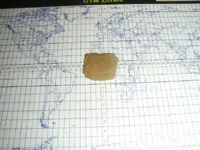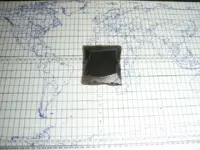spot
Jr. Member
Good afternoon,
Pictured is an un-used gunflint as would be used to provide the spark when the hammer holding it struck the frizzen of a flintlock rifle or pistol to ignite the powder in the pan and then through a small hole in the breech of the barrel to ignite the main charge and cause the gun to fire. These are not terribly unusual except that all the ones I have ever seen were worn out and had been discarded I'm sure. They become narrow and have a triangular shape when they are exhausted. They were formed by flint knappers who used soft steel hammers to "chip" them out in the late 1600's through the 1700's or even longer.
This particular gunflint is unusual in the sense that the flint is from France according to the late Greg Perino. He said that it would have been imported by boat to supply some French trading posts during the time periods mentioned above. These trading posts provided supplies to fur traders and trappers and also to local Native Americans in exchange for hides, bear fat, etc.
I recovered this inside the city limits of my city on a small bluff overlooking an old bayou that has now been channelized with concrete. There were a few homes being built on this little bluff and I found a few sherds, a broken point or two and this. The gunflint was 150 yards from the other items and was recovered with no supporting material.
Thanks for looking,
spot
Pictured is an un-used gunflint as would be used to provide the spark when the hammer holding it struck the frizzen of a flintlock rifle or pistol to ignite the powder in the pan and then through a small hole in the breech of the barrel to ignite the main charge and cause the gun to fire. These are not terribly unusual except that all the ones I have ever seen were worn out and had been discarded I'm sure. They become narrow and have a triangular shape when they are exhausted. They were formed by flint knappers who used soft steel hammers to "chip" them out in the late 1600's through the 1700's or even longer.
This particular gunflint is unusual in the sense that the flint is from France according to the late Greg Perino. He said that it would have been imported by boat to supply some French trading posts during the time periods mentioned above. These trading posts provided supplies to fur traders and trappers and also to local Native Americans in exchange for hides, bear fat, etc.
I recovered this inside the city limits of my city on a small bluff overlooking an old bayou that has now been channelized with concrete. There were a few homes being built on this little bluff and I found a few sherds, a broken point or two and this. The gunflint was 150 yards from the other items and was recovered with no supporting material.
Thanks for looking,
spot
Amazon Forum Fav 👍
Attachments
Upvote
0




















